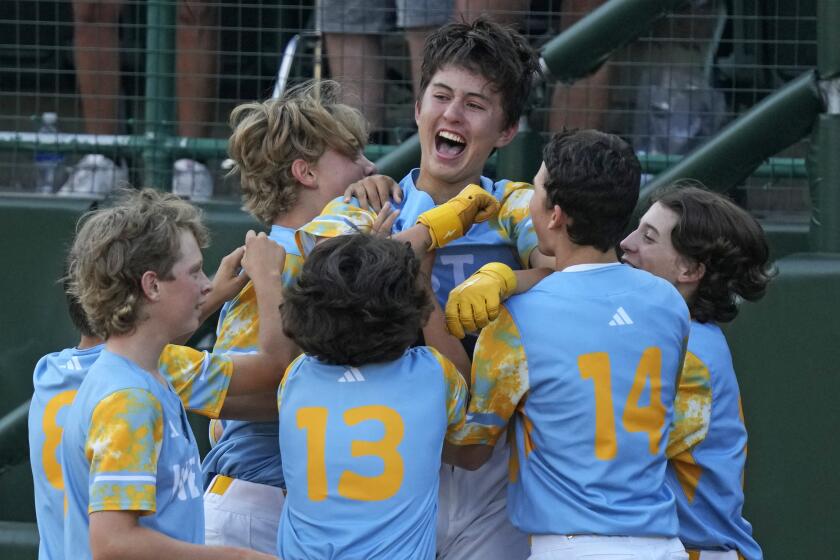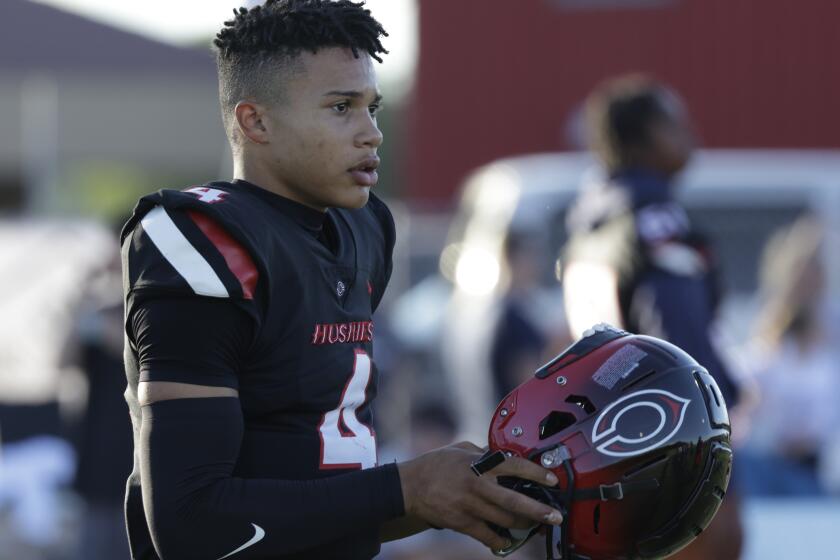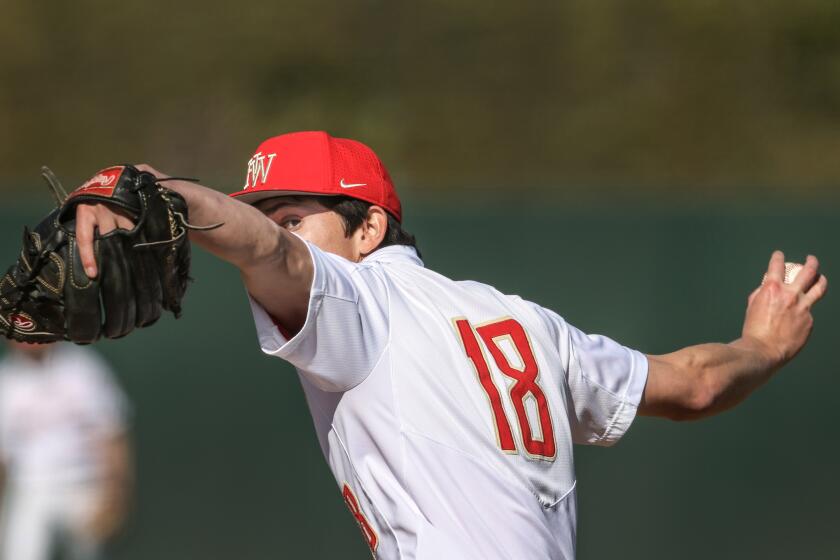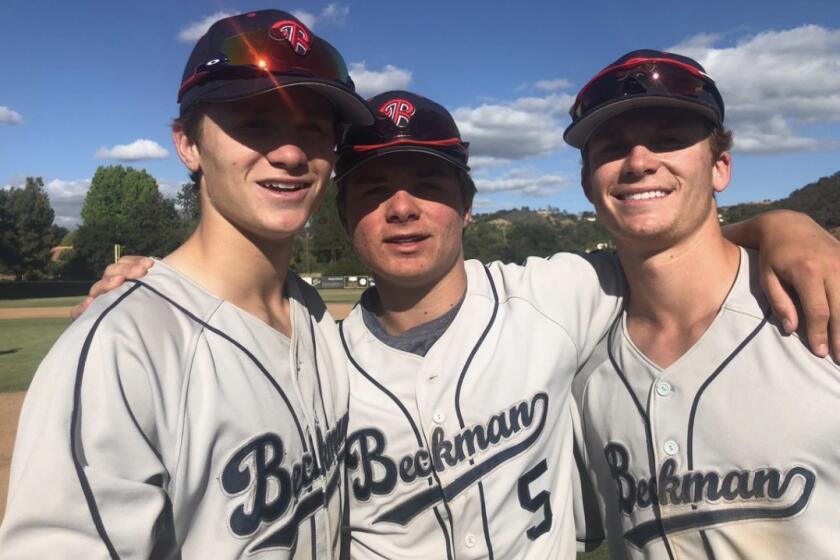No Free Rides : Getting Athletic Scholarships for College Tougher Than Most Students or Parents Think
Many parents dream of their son getting a football scholarship or their daughter a full-ride college scholarship. That . . . is unrealistic for most kids and parents.
--Irvine Unified School District Parents’ Handbook
For the record:
12:00 a.m. Nov. 8, 1995 For the Record
Los Angeles Times Wednesday November 8, 1995 Orange County Edition Sports Part C Page 7 Sports Desk 1 inches; 30 words Type of Material: Correction
College commitments--San Clemente’s Kate Turnbull will attend UC San Diego next year but has not decided whether she’ll play basketball, contrary to what was reported in Tuesday’s Times Orange County edition.
A college athletic scholarship.
By the time high school players become seniors, those words will have been drummed into their heads.
Just about all parents in these economically trying times want their kid to earn one. But not many do.
A 1993 study by the University of Utah found that only one out of every 100 high school athletes earn an athletic scholarship to a Division I school and only two of every 100 high school players get the opportunity to play college sports.
That’s not to say there aren’t colleges around the country willing to offer athletic scholarships. The top 20 to 40 athletes per sport nationwide, the so-called “blue chip” players, are highly visible and coveted.
But for the majority of high school athletes, the path to a college scholarship is almost always lined with pitfalls, hard work, careful career planning and the determination to succeed.
On the eve of another early signing period that begins Wednesday, it’s important for parents, coaches and athletes to understand it’s never too early to prepare for the future.
“You have to try to target the kids, early in their high school careers, that might have potential to go on to college,” Woodbridge Athletic Director Dave Cowen said. “You need to bring them in with their parents and let them know what their possibilities are and what they need to watch out for.”
So how do you go about getting an athletic scholarship?
Be Honest With Yourself
Not everyone is a blue chipper, although 50% of all high school football and basketball players surveyed for the Utah study believed they would get a scholarship.
“What you need to decide is, ‘Do I have the ability to play at the college level?’ ” said Dave Stoeckel, founder of Athletic Scholarship Information Services, a company that finds scholarships for a fee.
Scholarships are generally available at NCAA Division I and II schools and at most colleges that belong to the National Assn. of Intercollegiate Athletics (NAIA). NCAA Division III schools do not make scholarships available, but don’t count out a Division III school if you’re only looking for a place to continue playing while getting an education. Many grants and student-work programs are available to help defray costs.
Said UCLA assistant football coach Gary Bernardi, who heads up football recruiting for the Bruins: “Often, there are cases when kids have the wrong perception about where they belong in college. Not every athlete can play Division I. Sometimes, a kid can play Division II . . . They need to look for their right match.”
Ask your high school coaches for an honest evaluation. Compare yourself to others you have competed against. If you are a high school junior or senior with little or no club experience who is riding the bench in, say, girls’ volleyball, what are your chances for financial aid in college? Maybe a junior college is for you.
“Don’t feel guilty if you do not live up to your ideal of a super athlete,” writes George Henderson, professor of Human Relations at the University of Oklahoma in his nationally distributed manual, Academic Survival Tips for Student Athletes. “Set realistic goals for yourself and put sports in their proper prospective.”
Work with your parents to make some conclusions about your future, but don’t rely exclusively on them to assess your athletic abilities.
“A lot of parents are unrealistic in the expectations for their kids,” Cowen said. “In the back of their minds they view their kids as having tremendous skill and potential and they think that they are going to be wooed by all colleges, when, in actuality, that is very rarely the case.”
School Work
College athletic directors and coaches like to use the phrase “student-athlete.” When it comes to positioning yourself for a scholarship, the term applies.
Often the first things college recruiters look at are grades. That’s why it’s important to do well in high school. Many students, particularly freshmen, drop the ball.
“Parents and coaches should start early,” said Jim Muldoon, assistant commissioner of the Pacific 10 Conference, about stressing the importance of good grades to athletes. “So often a [student-athlete] gets to be a senior and they start looking ahead to college, but most of the time it is too late [to repair academic problems].”
Explained Stoeckel: “When coaches come looking for kids in their junior year, all they have to refer to the player are their freshmen and sophomore grades. A good student, say a 3.5 grade-point average that has scored above 1,100 on the [Scholastic Assessment Test], suddenly qualifies for more prestigious academic schools.”
That was the case for Marina standout soccer player Kristen Palmer, a National Merit Scholarship finalist now studying mathematics and physics at Northwestern.
“For Kristen, we needed a very, very strong academic program,” her mother, Tina, said. “Some schools came recruiting her just as a soccer player. That was the emphasis of the coach, and when Kristen began to ask questions about academics, she could see that wasn’t their emphasis.”
The NCAA also tightened admission requirements this fall. Students need a minimum GPA of 2.5 or higher on a four-point scale--up from a 2.0--to be eligible to compete in college as freshmen. That average must be maintained in 13 “core” classes, including selections from English, math and science.
Potential college freshmen with a 2.5 GPA also must score higher on the SAT or the American College Test than someone with a 3.5 GPA. Previously, a flat score of 700 on the SAT or 17 on the ACT was sufficient.
“The most important advice still remains that students need to take care of themselves from an academic perspective,” said Dan Guerrero, UC Irvine athletic director. “Students need to get themselves in the best possible position they can from an academic standpoint, obviously to make themselves available to more institutions.”
Do Your Homework
Don’t wait for schools to come looking for you. Pick out a dozen or so that you might want to attend. Most libraries have college reference guides that show the schools’ location, course offerings, available scholarships and climate.
Although you are allowed up to five paid visits to colleges that are actively recruiting you, it is a good idea to take unofficial trips with your parents to several of your choices.
The best time would be on a family vacation in the summer between your sophomore and junior years. That’s what junior Robin Beauregard, an top-flight water polo player from Marina High did with her family.
“If you are going on vacation, say, to Florida, drop into a college or two there just to look around,” said her mother, Marty Beauregard. “If you are going to a school back East, though, it’s better to make a visit in bad weather to see if you can handle snow and ice.”
If you cannot visit, write the school and request more information about housing, classes, jobs and student aid.
“Are you a match with the school?” said Mike Luker, principal of Vista View Middle School in Fountain Valley and a standout basketball player at the University of San Francisco from 1969 to 1971. He was a hot prospect coming out of Anaheim High in 1967. Luker had dozens of collegiate suitors, but he chose San Francisco because he felt most comfortable there.
“Boston College wanted me,” he said. “I would have no more gone to Boston College . . . I was from Southern California. It just didn’t feel right. I visited Arizona State. I didn’t like it. The people, the weather, the housing just weren’t right for me.”
Getting Recognized
More and more colleges are choosing athletes based on their performances for private, off-season club teams, as much as they are for their efforts in high school.
Mater Dei’s Roberta Gehlke, who has orally committed to play at UC Santa Barbara, has emerged as one of the top high school volleyball players in the county this season. But she first showcased her talent in front of more than 100 college coaches, 7,100 spectators and a national cable TV audience at the Davis Volleyball Festival last June, when she led the Orange County Volleyball Club 18 team to victory over OCVB 17 Blue.
“Coaches want to see intense play in club sports,” Stoeckel said. “High school, for the most part, college coaches don’t spend a lot of time on.”
But what if you don’t play club sports or you have played club and been overlooked? Experts say if you have not received letters or a phone call by the middle of your junior year, then it is highly unlikely you will be contacted at all.
In that case, if you have identified a list of schools you think you might want to attend, write a letter to the coach of your sport and introduce yourself. Stoeckel recommends that his clients write to between 50 and 100 schools. You could send a short videotape of your top performances. He also recommends students take the SAT test on the first available test date after July 1 of their junior year, and retake it, if necessary, until qualifying for college admission.
If you send out 100 letters, it’s likely about a couple of dozen schools will respond. Many will ask you to complete and return a questionnaire about yourself.
There are services that will do all that work for you, but for a fee, which ranges from consultations at about $50 an hour, right up to full-blown resumes, videos and mass mailings for about $1,000.
George and Jean Hammontree turned to Stoeckel when they were looking for a school for their son, Preston, a swimmer at Laguna Hills High. Preston is a freshman at Pitt.
“Preston sent out letters introducing himself to a sizable number of Division I schools in his junior year,” Jean Hammontree said of her son. “It got very time consuming and we turned to Dave. It’s like you have to market the kid.”
The Hammontrees paid Stoeckel about $500, they said.
Recruiting services are met with mixed reviews by college coaches and administrators. They help smaller schools around the country that don’t have large recruiting budgets. But they might not be able to do much to get athletes into the better-known schools, many of which spend hundreds of thousands of dollars annually identifying potential recruits.
A little hard work on your own will save you a lot of money and maybe get the same results.
Ask Questions
“As executive director of the NCAA,” said Cedric W. Dempsey in the introduction to the NCAA’s Guide for the College-bound Student-Athlete, “the best advice I can pass along if you plan to compete athletically at the college level is to start asking questions.”
The NCAA Guide offers a step-by-step rundown of the latest eligibility standards, the rules of recruiting, national test standards, rules for signing letters of intent. It explains the national Initial-Eligibility Clearinghouse, which was established three years ago to track athletes and their grades. All prospective college athletes who hope to play in divisions I or II must register with the clearinghouse through their high school counselors.
The National Federation of State High School Assns. publishes an easy-to-read, informative guide that is available to all athletic directors for a small fee and encourages them to hand it out to junior and senior athletes. In addition to Henderson’s Academic Survival tips for Student-Athletes, the federation guide details how to handle home visits by recruiters, provides questions to ask coaches and college players when making paid visitations and details NCAA rules about the recruiting process.
Some high schools, such as those in the Irvine Unified School District, put the quest for scholarships in perspective by writing and distributing parent handbooks. Understanding the college recruiting process is essential for parents, Woodbridge’s Cowen insists.
“We figure the more information [parents] have in their hands and the more talking they do about it, the better it is for them down the line so they are not being blindsided by the process,” he said. “At least they don’t feel short-changed because no one has informed them.”
Other schools offer free seminars. Stoeckel plays host to an information night each fall at Laguna Hills High for parents and athletes in the Saddleback Valley Unified School District.
Marty Beauregard suggests that students start by attending college nights that are sponsored several times a year at most high schools.
“You get a load of information from smaller schools, who may not have a lot of money to spend on scholarships, but at the same time you get a good idea of some of the questions you want to ask,” she said.
The Recruiting Process
There are a myriad of rules limiting the recruiting of high school athletes by college coaches. Most of those are spelled out plainly in the guides listed above.
If an athlete is offered a paid trip, for example, the high school federation says it is a good idea to find out in advance the financial arrangements of the visit, what clothes you should bring, if your parents will be welcome on the trip, who is paying for it and what expenses will be reimbursed.
Draw up a list of questions before you leave and ask them of players, coaches and teachers during the visit. Visit a class in session. Meet with players in the dorms.
Ask the coach specific questions as to what kind of scholarship you are being offered. Many under-funded schools split scholarships to maximize the number of top recruits they can get. Pin the coach down on your chances of playing as a freshman.
It is not wise to sign a letter of intent on the spot. Talk it over with your parents first. Sometimes, just signing the scholarship agreement will do.
Stoeckel suggests to all of his clients that on the way back from the visit they should make a list of all the things they liked and didn’t like.
“I tell them to ask themselves, that, if for some reason, they had a career-ending injury in their freshman year, would they still be happy at this school?” he said.
Why Are We Here?
Because there is so much information to process about the recruiting process, parents and high school athletes forget that going to college is not about playing sports, but about learning.
“First you must realize that you, as a student-athlete, are here to get an education,” said UCI’s Guerrero.
In his introductory letter in the NCAA Guide for the College-Bound Student-Athlete, Dempsey points out there are nearly one million high school football players, yet the odds of playing in the National Football League for those players are about 6,000 to one.
“Instead of focusing on which college can lead to a career in the pros. . .,” he wrote, “take a hard look at those numbers and think about what will matter in the long run--a college education.”
Times staff writers Wendy Witherspoon and Lonnie White contributed to this story.
(BEGIN TEXT OF INFOBOX / INFOGRAPHIC)
Help Along the Recruiting Trail
NCAA Guide for the College-Bound Student Athlete, $5; NCAA Guide for Financial Aid, $5.
NCAA Publishing, P.O. Box 7347, Overland Park, Kan. 66207-0347.
Clearinghouse Hotline, (319) 337-1492.
National Interscholastic Athletic Administration Assn. Guide for College-Bound Student Athletes and Parents (available through most high school athletic departments), (816) 464-5400. $5
RECRUITING SERVICES
Athletic Scholarship Information Services, 24831 Alicia Parkway, Suite C202, Laguna Hills, Calif., 92653, (714) 830-5735.
College Bound Student-Athlete, 23861 El Toro Road, Suite 700, El Toro, Calif. 92630, (714) 588-2326.
Court Magazine (Western Girls Athletic Services), P.O. Box 1838, Oxnard, Calif. 93030, (805) 647-4700.
Double-Pump, 800-678-0935.
Scouting Evaluation Assn., P.O. Box 651, Fallbrook, Calif. 92028, (619) 728-7505.
Super Prep, P.O. Box 487, Laguna Beach, Calif. 92652, (714) 494-7866.
TEST DATES
SAT: Dec. 2, 1995; Jan. 27, 1996; March 23, 1996; May 4, 1996; June 1, 1996.
ACT: Dec. 9, 1995; Feb. 3, 1996; April 13, 1996; June 8, 1996.
* Some tips:
--Take a realistic look at the student-athlete’s athletic ability and college potential.
--Enroll in college preparatory courses throughout high school career.
--Good grades make student-athletes more palatable to most colleges.
--Research which colleges student-athlete is interested in.
--Know NCAA guidelines for academic and athletic eligibility.
--Take PSAT early in junior year.
--Enroll in an after-school SAT or ACT study program.
--Take SAT test for the first time no later than May of junior year.
--Take SAT or ACT at least twice during senior year. (Between the two tests, student can take entrance exams as many as 10 times before graduation).
--Do not discount attending a junior college.
* NCAA Scholarship Core Courses for 1995-96
--At least four years English.
--At least two years math (one year algebra and one year geometry, or one year of a higher-level math course for which geometry is a prerequisite).
--At least two years social science.
--At least two years natural or physical science (including one lab course, if offered by your school).
--At least one year of additional courses in English, math or natural or physical science; and two additional academic courses in any of the above areas or foreign language, computer science, philosophy or comparative religion.
* Test Score Requirements
SAT : 820 and a 2.5 GPA; sliding scale 1,010 and a 2.0 GPA.
ACT : 68 (based on sum of four sub-scores) and a 2.5 or above grade-point average; sliding scale to 86 and a 2.0 GPA.
Local High School Signings
A partial list of Orange County athletes who have orally committed to play in college.
BASEBALL *--*
Player School Pos. College Mike Hessman Mater Dei P/Inf Arizona Ryan Owens Sonora SS CS Fullerton
*--*
BOYS’ BASKETBALL *--*
Player School Pos. College Josh Greer Esperanza F St. Mary’s Allen Krist Santa Margarita C SMU Olujimi Mann Santa Ana Valley G UCLA Dane Plock Estancia G CS Fullerton
*--*
GIRLS’ BASKETBALL *--*
Player School Pos. College Raschelle Lawrence University G Nichols State Allison Luckey Mater Dei G Pacific Melanie Pearson Woodbridge F UCLA Melody Peterson Mater Dei G Stanford Marie Philman Edison F UCLA Nicole Strange Fountain Valley F Oregon Kate Turnbull San Clemente F UC San Diego
*--*
SOFTBALL *--*
Player School Pos. College Angie Fancuberta Fullerton P Rutgers Dana Gulick El Toro OF Arkansas Brooke Hofstetter Mater Dei P Oregon State Tammy Kincaid Villa Park P Arkansas Gretchen Thompson Brea Olinda P-SS Arkansas Lisa Tully Mater Dei 3B Notre Dame
*--*
GIRLS’ TRACK AND FIELD *--*
Player School College Kerry O’Bric Edison Baylor
*--*
GIRLS’ VOLLEYBALL *--*
Player School Pos. College Heather Brown Esperanza Out. hitter UC Santa Barbara Kelly Campbell Corona del Mar Setter Colorado Michelle Christ Laguna Beach Opp. hitter Oregon Lydia Day El Toro Mid. blkr. Loyola Marymount Jami Ediger La Habra Mid. blkr. Duke Roberta Gehlke Mater Dei Out. hitter UC Santa Barbara Jenny Roberts Calvary Chapel Mid. blkr. Hawaii Taryn Catlin Sunny Hills Setter Purdue
*--*
Get our high school sports newsletter
Prep Rally is devoted to the SoCal high school sports experience, bringing you scores, stories and a behind-the-scenes look at what makes prep sports so popular.
You may occasionally receive promotional content from the Los Angeles Times.



